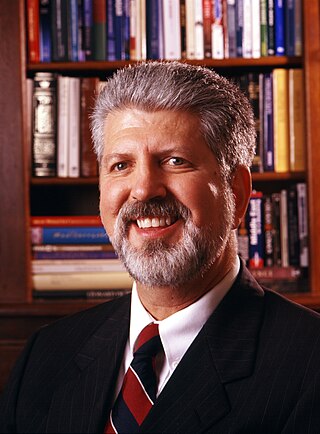
Monoamine neurotransmitters are neurotransmitters and neuromodulators that contain one amino group connected to an aromatic ring by a two-carbon chain (such as -CH2-CH2-). Examples are dopamine, norepinephrine and serotonin.
The Oxford English Dictionary defines religiosity as: "Religiousness; religious feeling or belief. [...] Affected or excessive religiousness". Different scholars have seen this concept as broadly about religious orientations and degrees of involvement or commitment. Religiosity is measured at the levels of individuals or groups and there is a lack of agreement on what criteria would constitute religiosity among scholars. Sociologists of religion have observed that an individual's experience, beliefs, sense of belonging, and behavior often are not congruent with their actual religious behavior, since there is much diversity in how one can be religious or not. Multiple problems exist in measuring religiosity. For instance, measures of variables such as church attendance produce different results when different methods are used - such as traditional surveys vs time-use surveys.

Monoamine transporters (MATs) are proteins that function as integral plasma-membrane transporters to regulate concentrations of extracellular monoamine neurotransmitters. The three major classes are serotonin transporters (SERTs), dopamine transporters (DATs), and norepinephrine transporters (NETs) and are responsible for the reuptake of their associated amine neurotransmitters. MATs are located just outside the synaptic cleft (peri-synaptically), transporting monoamine transmitter overflow from the synaptic cleft back to the cytoplasm of the pre-synaptic neuron. MAT regulation generally occurs through protein phosphorylation and post-translational modification. Due to their significance in neuronal signaling, MATs are commonly associated with drugs used to treat mental disorders as well as recreational drugs. Compounds targeting MATs range from medications such as the wide variety of tricyclic antidepressants, selective serotonin reuptake inhibitors such as fluoxetine (Prozac) to stimulant medications such as methylphenidate (Ritalin) and amphetamine in its many forms and derivatives methamphetamine (Desoxyn) and lisdexamfetamine (Vyvanse). Furthermore, drugs such as MDMA and natural alkaloids such as cocaine exert their effects in part by their interaction with MATs, by blocking the transporters from mopping up dopamine, serotonin, and other neurotransmitters from the synapse.
The vesicular monoamine transporter (VMAT) is a transport protein integrated into the membranes of synaptic vesicles of presynaptic neurons. It transports monoamine neurotransmitters – such as dopamine, serotonin, norepinephrine, epinephrine, and histamine – into the vesicles, which release the neurotransmitters into synapses, as chemical messages to postsynaptic neurons. VMATs utilize a proton gradient generated by V-ATPases in vesicle membranes to power monoamine import.

Reserpine is a drug that is used for the treatment of high blood pressure, usually in combination with a thiazide diuretic or vasodilator. Large clinical trials have shown that combined treatment with reserpine plus a thiazide diuretic reduces mortality of people with hypertension. Although the use of reserpine as a solo drug has declined since it was first approved by the FDA in 1955, the combined use of reserpine and a thiazide diuretic or vasodilator is still recommended in patients who do not achieve adequate lowering of blood pressure with first-line drug treatment alone. The reserpine-hydrochlorothiazide combo pill was the 17th most commonly prescribed of the 43 combination antihypertensive pills available In 2012.

Dean Hamer is an American geneticist, author, and filmmaker. He is known for his research on the role of genetics in sexual orientation and for a series of popular books and films that have changed scientific and public understandings and perceptions of human sexuality and gender.
In philosophy, transcendence is the basic ground concept from the word's literal meaning, of climbing or going beyond, albeit with varying connotations in its different historical and cultural stages. It includes philosophies, systems, and approaches that describe the fundamental structures of being, not as an ontology, but as the framework of emergence and validation of knowledge of being. These definitions are generally grounded in reason and empirical observation and seek to provide a framework for understanding the world that is not reliant on religious beliefs or supernatural forces. "Transcendental" is a word derived from the scholastic, designating the extra-categorical attributes of beings.

The dopamine transporter is a membrane-spanning protein coded for in the human by the SLC6A3 gene, that pumps the neurotransmitter dopamine out of the synaptic cleft back into cytosol. In the cytosol, other transporters sequester the dopamine into vesicles for storage and later release. Dopamine reuptake via DAT provides the primary mechanism through which dopamine is cleared from synapses, although there may be an exception in the prefrontal cortex, where evidence points to a possibly larger role of the norepinephrine transporter.

The solute carrier family 18 member 2 (SLC18A2) also known as vesicular monoamine transporter 2 (VMAT2) is a protein that in humans is encoded by the SLC18A2 gene. SLC18A2 is an integral membrane protein that transports monoamines—particularly neurotransmitters such as dopamine, norepinephrine, serotonin, and histamine—from cellular cytosol into synaptic vesicles. In nigrostriatal pathway and mesolimbic pathway dopamine-releasing neurons, SLC18A2 function is also necessary for the vesicular release of the neurotransmitter GABA.

Vesicular monoamine transporter 1 (VMAT1) also known as chromaffin granule amine transporter (CGAT) or solute carrier family 18 member 1 (SLC18A1) is a protein that in humans is encoded by the SLC18A1 gene. VMAT1 is an integral membrane protein, which is embedded in synaptic vesicles and serves to transfer monoamines, such as norepinephrine, epinephrine, dopamine, and serotonin, between the cytosol and synaptic vesicles. SLC18A1 is an isoform of the vesicular monoamine transporter.

Trace amine-associated receptor 1 (TAAR1) is a trace amine-associated receptor (TAAR) protein that in humans is encoded by the TAAR1 gene. TAAR1 is an intracellular amine-activated Gs-coupled and Gq-coupled G protein-coupled receptor (GPCR) that is primarily expressed in several peripheral organs and cells, astrocytes, and in the intracellular milieu within the presynaptic plasma membrane of monoamine neurons in the central nervous system (CNS). TAAR1 was discovered in 2001 by two independent groups of investigators, Borowski et al. and Bunzow et al. TAAR1 is one of six functional human trace amine-associated receptors, which are so named for their ability to bind endogenous amines that occur in tissues at trace concentrations. TAAR1 plays a significant role in regulating neurotransmission in dopamine, norepinephrine, and serotonin neurons in the CNS; it also affects immune system and neuroimmune system function through different mechanisms.

Solute carrier family 22 member 3 (SLC22A3) also known as the organic cation transporter 3 (OCT3) or extraneuronal monoamine transporter (EMT) is a protein that in humans is encoded by the SLC22A3 gene.
The Temperament and Character Inventory (TCI) is an inventory for personality traits devised by Cloninger et al. It is closely related to and an outgrowth of the Tridimensional Personality Questionnaire (TPQ), and it has also been related to the dimensions of personality in Zuckerman's alternative five and Eysenck's models and those of the five factor model.

The evolutionary origin of religion and religious behavior is a field of study related to evolutionary psychology, the origin of language and mythology, and cross-cultural comparison of the anthropology of religion. Some subjects of interest include Neolithic religion, evidence for spirituality or cultic behavior in the Upper Paleolithic, and similarities in great ape behavior.

Claude Robert Cloninger is an American psychiatrist and geneticist noted for his research on the biological, psychological, social, and spiritual foundation of both mental health and mental illness. He previously held the Wallace Renard Professorship of Psychiatry, and served as professor of psychology and genetics, as well as director of the Sansone Family Center for Well-Being at Washington University in St. Louis. Cloninger is a member of the evolutionary, neuroscience, and statistical genetics programs of the Division of Biology and Biomedical Sciences at Washington University, and is recognized as an expert clinician in the treatment of general psychopathology, substance dependence, and personality disorders. Dr. Cloninger is currently professor emeritus.
In psychology, novelty seeking (NS) is a personality trait associated with exploratory activity in response to novel stimulation, impulsive decision making, extravagance in approach to reward cues, quick loss of temper, and avoidance of frustration. That is, novelty seeking refers to the tendency to pursue new experiences with intense emotional sensations. It is a multifaceted behavioral construct that includes thrill seeking, novelty preference, risk taking, harm avoidance, and reward dependence. The novelty-seeking trait is considered a heritable tendency of individuals to take risks for the purpose of achieving stimulation and seeking new environments and situations that make their experiences more intense. This trait has been associated with the level of motive and excitement in response to novelty. Persons with high levels of novelty seeking have been described as more impulsive and disorderly than low novelty seekers and have a higher propensity to get involved in risky activities, such as starting to misuse drugs, engaging in risky sexual activities, and suffering accidental injuries. It is measured in the Tridimensional Personality Questionnaire as well as the later version Temperament and Character Inventory and is considered one of the temperament dimensions of personality. Like the other temperament dimensions, it has been found to be highly heritable. Another related term, Variety seeking or variety-seeking buying behavior describes a consumer's desire to search for alternative products even if she or he is satisfied with a current product. For example, someone may drink tea with lunch one day but choose orange juice the next day specifically to get something different. High NS has been suggested to be related to low dopaminergic activity.

A monoamine releasing agent (MRA), or simply monoamine releaser, is a drug that induces the release of a monoamine neurotransmitter from the presynaptic neuron into the synapse, leading to an increase in the extracellular concentrations of the neurotransmitter. Many drugs induce their effects in the body and/or brain via the release of monoamine neurotransmitters, e.g., trace amines, many substituted amphetamines, and related compounds.

3-Fluoroamphetamine is a stimulant drug from the amphetamine family which acts as a monoamine releaser with similar potency to methamphetamine but more selectivity for dopamine and norepinephrine release over serotonin. It is self-administered by mice to a similar extent to related drugs such as 4-fluoroamphetamine and 3-methylamphetamine.
Self-transcendence is a personality trait that involves the expansion or evaporation of personal boundaries. This may potentially include spiritual experiences such as considering oneself an integral part of the universe. Several psychologists, including Viktor Frankl, Abraham Maslow, and Pamela G. Reed have made contributions to the theory of self-transcendence.
Personality traits are patterns of thoughts, feelings and behaviors that reflect the tendency to respond in certain ways under certain circumstances.











